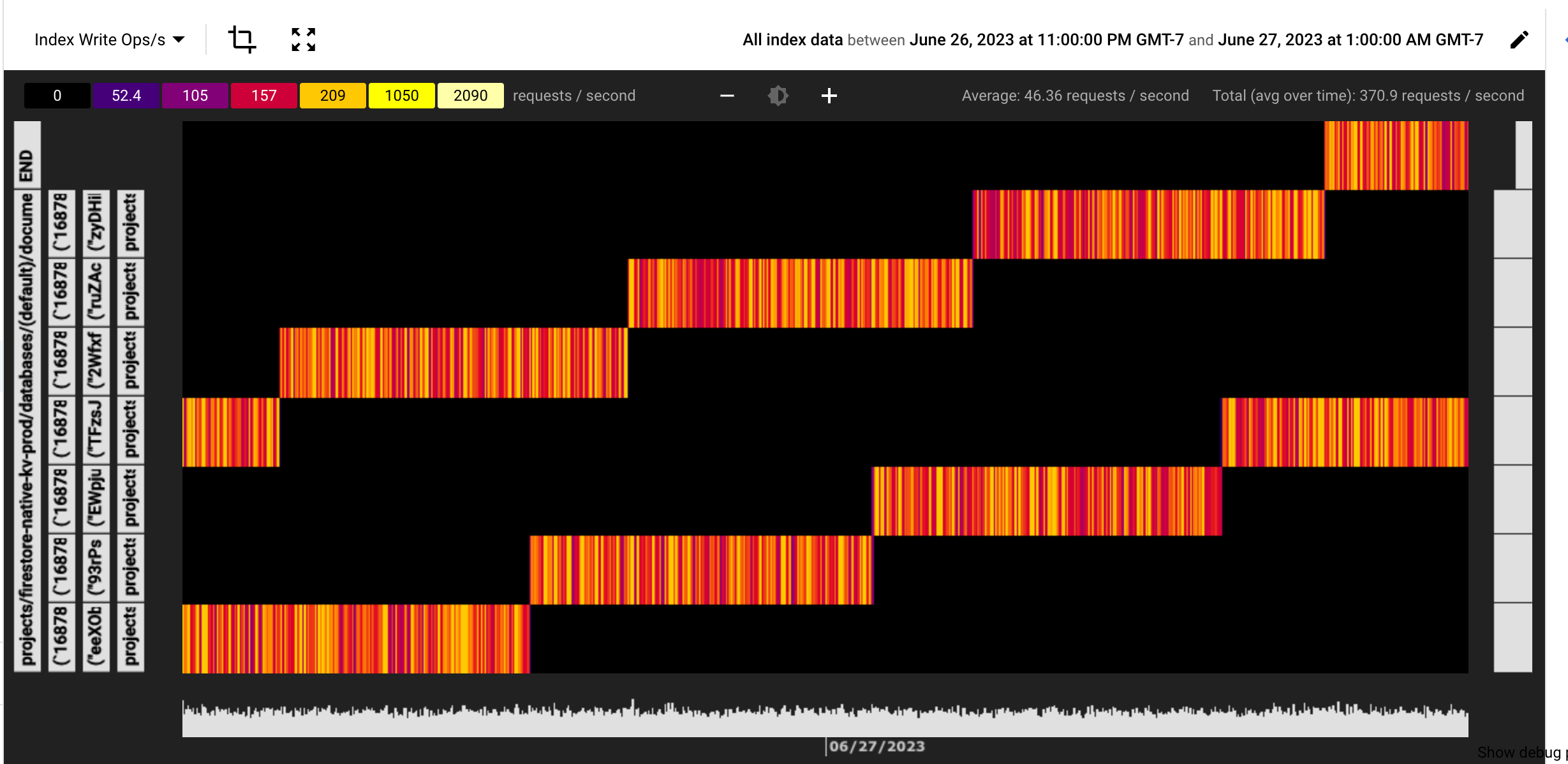Heatmap patterns for index keys
This page shows examples of patterns that you might see in a Key Visualizer heatmap. These patterns can help you troubleshoot specific performance issues.
Evenly distributed usage

If a heatmap shows a fine-grained mix of dark and bright colors, then write/delete operations for index keys are evenly distributed throughout the database. This heatmap likely represents an effective usage pattern for Firestore.
Indexes on sequential keys
A heatmap with a single bright diagonal line can indicate an index that is on a key that is strictly increasing or decreasing, such as timestamp. Indexes on sequential keys are not recommended and can create hotspots. When hotspotting, you might observe corresponding elevated latencies.
Some examples of common hotspots on index are as follows:
Hotspotting due to increasing timestamp

In this example, a heatmap with a single bright diagonal line can indicate a database that uses strictly increasing or decreasing index write/delete operations on a timestamp field name.
Hotspotting due to increasing field names

In this example, a heatmap with a single bright diagonal line can indicate a database that uses strictly increasing or decreasing index write/delete operations on an incremental field, such as auto-generated invoice numbers.
To identify the hotspotting issue, use the Key Visualizer tool and understand the index key structure to determine which index causes the issue and exempt those indexes with best practices.
Understand the index key structure
Before you understand the structure of index keys that you see in Key Visualizer tool, learn about indexes in Firestore.
The following code shows an example index key format that you see when you hover over the affected key-range on the heatmap.
COLLECTION: projects/PROJECT_ID/databases/(default)/documents/Users
PROPERTIES: (Timestamp: DESC)
VALUES: (16500000000000001)
DOCUMENT: projects/PROJECT_ID/databases/(default)/documents/Users/5000000000000001
Where:
- COLLECTION: location of the collection in your database. Based on the scope, it can be collection path for collection scope or collection name for collection group scope.
- PROPERTIES: fields used to create the index. The
__name__ordering property is only shown for index definitions that modify the default ordering. - VALUES: value of each property.
- DOCUMENT: ID of the document updated in an operation.
From the earlier example, identify the fields from the PROPERTIES value to find the affected index.
To find the index, complete the following steps:
In the Google Cloud console, go to the Databases page.
Select the required database from the list of databases.
In the navigation menu, click Indexes.
Go to the Composite or Single Field tab.
You can identify the type of index by analyzing the PROPERTIES field. See examples of index keys for more information.
Click Filter, select Fields, and enter the name of the field.
Use the OR operator to add more fields in case of composite indexes.
After you have identified the index that is causing issues, you can use the following solutions:
Composite index: Either modify the index to ensure that the field whose value monotonically increases or decreases is not selected as the first field for indexing, or delete the index.
Single-field index: Add an exemption for the field and the sorting order that you want to exempt. See Adding a single-field exemption for more information.
Examples of index key entries on the heatmap
| Type | Description | Example |
|---|---|---|
| Collection scope single-field Indexes ASC, DESC | Firestore creates indexes with collection scope by default. Index entry for the single-field Index on the Timestamp field, in descending order for the Users/5000000000000001 document. |
COLLECTION: projects/PROJECT_ID/databases/(default)/documents/UsersPROPERTIES: (Timestamp: DESC)VALUES: (16500000000000001)DOCUMENT: projects/PROJECT_ID/databases/(default)/documents/Users/5000000000000001 |
| Collection scope single-field Indexes for array fields | For each array field in a document, Firestore creates and maintains a collection scope array-contains index. Index entry for array-contains mode single-field indexes that will be created when a field Country: [USA, Japan] is added to the document. Note that ASC,DESC indexes will also be created by default for this field. The example shows the ASC index for the Country field. |
COLLECTION: projects/PROJECT_ID/databases/(default)/documents/UsersPROPERTIES:(Country: ASC)VALUES:([USA, Japan]) DOCUMENT:(projects/PROJECT_ID/databases/(default)/documents/Users/5000000000000001) |
| Collection group single-field Indexes ASC, DESC, ARRAY | A collection group includes all collections with the same collection ID. Index entry for the collection group single-field Index on the Timestamp field, in descending order. |
COLLECTION GROUP: UsersPROPERTIES: (Timestamp: DESC)VALUES: (16500000000000001L) DOCUMENT: projects/PROJECT_ID/databases/(default)/documents/Users/5000000000000001 |
| Collection group single-field Indexes ASC, DESC, ARRAY | Index entry for the collection group single-field Index on Country field in the array-contains mode |
COLLECTION GROUP: Users PROPERTIES: (Country: ARRAY ASC) VALUES: (USA) DOCUMENT: projects/PROJECT_ID/databases/(default)/documents/Users/5000000000000001 |
| Collection composite index entry with ASC, ASC, ARRAY properties | Composite index entries with parent are created when nested documents are created with collection scope index definition.Index entry for composite index with Timestamp and Name field in ascending order, and Country in array-contains mode. |
COLLECTION: projects/PROJECT_ID/databases/(default)/documents/UsersPROPERTIES: (Timestamp: ASC, Name: ASC,Country: ARRAY)VALUES: (16500000000000001L, 'Alice', 'USA')DOCUMENT: (projects/PROJECT_ID/databases/(default)/documents/Users/5000000000000001) |
| Collection group scope composite index entry with ASC, ASC properties | Index entry for the composite index on the Timestamp field, in ascending order and Name field in ascending order |
COLLECTION GROUP: UsersPROPERTIES: (Timestamp: ASC, Name: ASC)VALUES: (16500000000000001L, 'Alice')DOCUMENT: (projects/PROJECT_ID/databases/(default)/documents/Users/5000000000000001) |
Collection scope composite Index entry with ASC and __name__ properties |
Index entry for the composite Index on the Timestamp field in ascending order and with __name__ sorting in descending order for the Users/5000000000000001 document. You can use __name__ as the final field in an index definition to change the default ordering of results. |
COLLECTION: projects/PROJECT_ID/databases/(default)/documents/UsersPROPERTIES: (Timestamp: ASC, __name__ DESC)VALUES: (16500000000000001)DOCUMENT: projects/PROJECT_ID/databases/(default)/documents/Users/5000000000000001 |
What's next
- Learn how to get started with Key Visualizer.
- Find out how to explore a heatmap in detail.
- Read about the metrics you can view in a heatmap.
